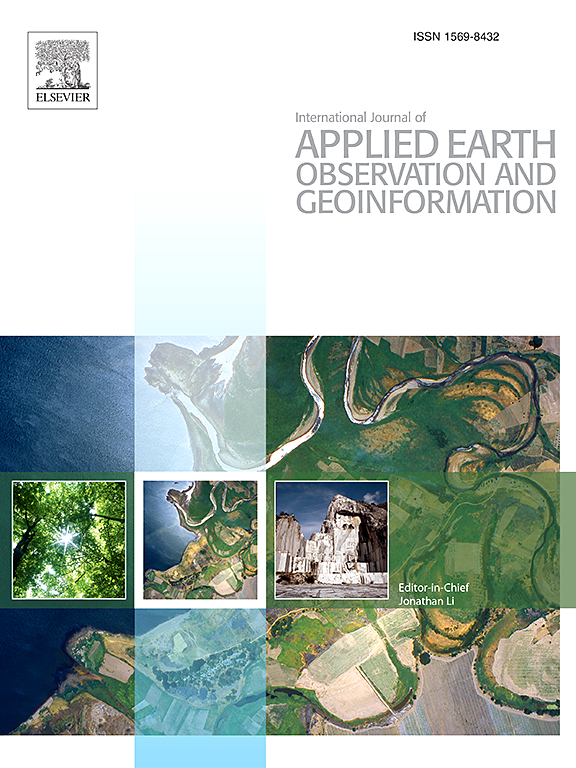A hybrid framework for estimating photovoltaic dust content based on UAV hyperspectral images
IF 7.6
Q1 REMOTE SENSING
International journal of applied earth observation and geoinformation : ITC journal
Pub Date : 2025-03-26
DOI:10.1016/j.jag.2025.104500
引用次数: 0
Abstract
Dust is one of the key factors influencing photovoltaic (PV) power generation. The ability to accurately capture PV dust information is essential for PV operation and sustainable utilization. This study employs uncrewed aerial vehicle (UAV) hyperspectral imaging to monitor PV dust deposition. To address the problems of information redundancy in hyperspectral data and the backpropagation neural network (BPNN) easily falling into local optimum, a high-precision UAV hyperspectral PV dust estimation method is proposed. The fractional order derivative (FOD) is applied to the spectral reflectance of PV dust accumulation, and a PV dust estimation model with sine map tuna swarm optimized backpropagation neural network (STSO-BPNN) is established, which is validated using UAV hyperspectral images and ground measured dust data. The results show that FOD improves the spectral signal-to-noise ratio, and the 0.2 order STSO-BPNN model achieves higher accuracy (R2 = 0.95, RMSE = 0.79 g/m2, RPIQ = 7.98). These findings provide a scientific basis for the rapid and accurate estimation and mapping of PV dust accumulation while proposing a novel strategy for efficient PV implementation and management.
基于无人机高光谱影像的光伏粉尘含量估算混合框架
粉尘是影响光伏发电的关键因素之一。准确捕获光伏粉尘信息的能力对于光伏运行和可持续利用至关重要。本研究采用无人机(UAV)高光谱成像技术监测光伏粉尘沉积。针对高光谱数据信息冗余和反向传播神经网络易陷入局部最优的问题,提出了一种高精度无人机高光谱光伏粉尘估计方法。将分数阶导数(FOD)应用于光伏粉尘堆积的光谱反射率,建立了基于正弦图金枪鱼群优化反向传播神经网络(STSO-BPNN)的光伏粉尘估计模型,并利用无人机高光谱图像和地面实测粉尘数据对模型进行了验证。结果表明,FOD提高了谱信噪比,0.2阶STSO-BPNN模型获得了更高的精度(R2 = 0.95, RMSE = 0.79 g/m2, RPIQ = 7.98)。这些研究结果为快速准确地估算和绘制PV积尘量提供了科学依据,同时为PV的有效实施和管理提供了新的策略。
本文章由计算机程序翻译,如有差异,请以英文原文为准。
求助全文
约1分钟内获得全文
求助全文
来源期刊

International journal of applied earth observation and geoinformation : ITC journal
Global and Planetary Change, Management, Monitoring, Policy and Law, Earth-Surface Processes, Computers in Earth Sciences
CiteScore
12.00
自引率
0.00%
发文量
0
审稿时长
77 days
期刊介绍:
The International Journal of Applied Earth Observation and Geoinformation publishes original papers that utilize earth observation data for natural resource and environmental inventory and management. These data primarily originate from remote sensing platforms, including satellites and aircraft, supplemented by surface and subsurface measurements. Addressing natural resources such as forests, agricultural land, soils, and water, as well as environmental concerns like biodiversity, land degradation, and hazards, the journal explores conceptual and data-driven approaches. It covers geoinformation themes like capturing, databasing, visualization, interpretation, data quality, and spatial uncertainty.
 求助内容:
求助内容: 应助结果提醒方式:
应助结果提醒方式:


